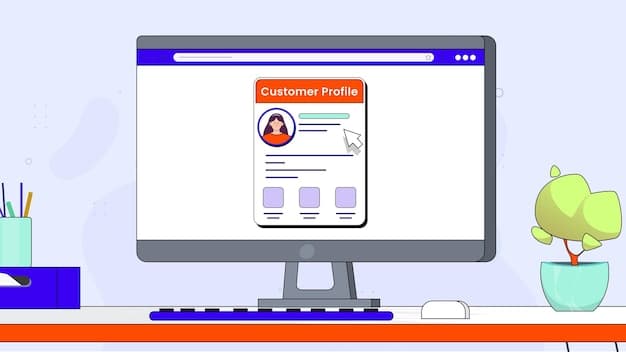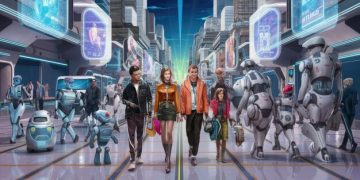AI in Hiring: What US Job Seekers Must Know (2025)

The Impact of AI on Hiring Practices is profoundly reshaping how US job seekers navigate the employment landscape, influencing everything from resume screening to interview processes and requiring a proactive understanding to succeed.
The rise of artificial intelligence (AI) is no longer a futuristic concept; it’s a present-day reality transforming industries across the United States. One of the most significant areas of impact is in hiring practices. For US job seekers, understanding the impact of AI on hiring practices is crucial to navigating the modern job market successfully. This article explores how AI is changing the game and what you need to know to stay ahead.
Understanding AI in Hiring: An Overview
Artificial intelligence is rapidly changing the way companies recruit and select candidates. From automated resume screening to AI-powered interviews, the use of these technologies is transforming the hiring landscape. Understanding these changes is vital for US job seekers.
AI systems can analyze vast amounts of data with speed and accuracy, allowing recruiters to filter through hundreds or even thousands of applications quickly. This can save time and resources but also presents new challenges for candidates.
How AI is Used in Recruitment
AI tools are integrated into various stages of the recruitment process, offering both advantages and potential pitfalls. Knowing how these tools work can help job seekers tailor their approach.
- Resume Screening: AI-powered Applicant Tracking Systems (ATS) scan resumes for keywords, skills, and experience, filtering out candidates who don’t meet the predefined criteria.
- Candidate Sourcing: AI algorithms can identify potential candidates from online platforms, social media, and professional networks.
- AI Chatbots: These chatbots engage with candidates, answering initial questions and providing information about job openings.
- Video Interviews: AI analyzes candidates’ facial expressions, tone of voice, and word choice during video interviews to assess their suitability for the role.
Job seekers need to understand how these AI tools operate to optimize their applications and interview performance.
In conclusion, AI’s role in hiring is multifaceted, impacting everything from initial screenings to final candidate selections. Understanding this landscape is the first step for US job seekers to adapt and succeed.

Optimizing Your Resume for AI Screening
One of the first points of contact between a job seeker and a potential employer is often through an AI-powered ATS. Therefore, optimizing your resume for these systems is crucial to ensure it passes the initial screening.
An ATS evaluates resumes based on specific criteria, including keywords, skills, and formatting. If your resume doesn’t align with these criteria, it may be automatically rejected, regardless of your qualifications.
Key Strategies for ATS Optimization
To increase your chances of making it past the ATS, consider these strategies:
- Use Relevant Keywords: Identify the key skills and qualifications mentioned in the job description and incorporate them into your resume.
- Choose the Right Format: Use a simple, clean format that ATS can easily read. Avoid complex designs, tables, and images.
- Tailor Your Resume: Customize your resume for each job application to match the specific requirements and keywords.
By understanding how ATS works and tailoring your resume accordingly, you can significantly improve your chances of getting your application in front of a human recruiter.
Optimizing your resume for AI screening is an essential part of modern job searching. Focus on incorporating relevant keywords, maintaining a clear format, and tailoring your application to each specific job.
Mastering the AI Video Interview
Video interviews are becoming increasingly common, and AI is often used to analyze candidates’ responses and behaviors during these interviews. This adds a new dimension to the interview process, requiring job seekers to prepare accordingly.
AI evaluates various aspects of your performance, including your facial expressions, tone of voice, and the words you use. Understanding what these systems look for can help you present yourself in the best possible light.
Tips for Acing AI Video Interviews
- Practice Your Delivery: Record yourself answering common interview questions and analyze your performance.
- Maintain Eye Contact: Look directly at the camera to simulate eye contact with the interviewer.
- Be Mindful of Your Body Language: Maintain a confident posture and avoid fidgeting.
Preparing for an AI video interview involves practicing your delivery, maintaining eye contact, and being mindful of your body language. Mastering these elements can help you make a positive impression.
In conclusion, AI-driven video interviews demand careful preparation and a keen awareness of your presentation. By practicing and refining these skills, you can significantly improve your performance and stand out to potential employers.

Building a Strong Online Presence
In today’s digital age, your online presence can significantly impact your job search. Recruiters often use social media and professional networking sites to learn more about candidates. Therefore, building and maintaining a strong online presence is crucial.
Your online profiles can provide additional context and insights beyond your resume and cover letter. They can also demonstrate your expertise and passion for your field.
Strategies for Enhancing Your Online Presence
- Optimize Your LinkedIn Profile: Use a professional headshot, write a compelling summary, and highlight your skills and experience.
- Engage on Social Media: Share relevant content, participate in industry discussions, and connect with professionals in your field.
A strong online presence can significantly enhance your job search efforts, helping you stand out to potential employers and demonstrate your value.
Building a strong online presence requires consistent effort and attention. By optimizing your online profiles and engaging with relevant content, you can significantly enhance your job search and career prospects.
Addressing Bias in AI Hiring Systems
While AI offers many benefits in hiring, it’s crucial to acknowledge the potential for bias. AI systems are trained on data, and if that data reflects existing biases, the AI can perpetuate and even amplify those biases.
Bias in AI hiring systems can lead to unfair or discriminatory outcomes, disadvantaging certain groups of job seekers. Understanding these issues is essential for both job seekers and employers.
Understanding and Overcoming Bias
There are several things that can be done to mitigate bias in AI hiring systems:
- Auditing AI Algorithms: Regularly audit AI algorithms to identify and correct any biases.
- Diversifying Training Data: Use diverse data sets to train AI systems and avoid perpetuating existing biases.
- Human Oversight: Implement human oversight to ensure fair and equitable outcomes.
Addressing bias in AI hiring systems requires a proactive and ongoing effort. By understanding these issues and implementing effective mitigation strategies, job seekers and employers can work towards fairer and more equitable outcomes.
Addressing bias in AI hiring is essential to ensure fairness and equity in hiring practices. Both job seekers and employers must be aware of these issues and take steps to mitigate their impact.
Preparing for the Future of AI in Hiring
As AI technology continues to evolve, its role in hiring will only become more significant. To thrive in this evolving landscape, US job seekers need to stay informed, adaptable, and proactive.
Keeping abreast of new developments and trends in AI in hiring can help you anticipate changes and prepare accordingly. Adaptability and a willingness to learn are essential qualities in this environment.
Staying Ahead of the Curve
Follow these tips to stay ahead:
- Continuous Learning: Stay updated on the latest trends and developments in AI and hiring practices.
- Networking: Connect with professionals in the HR and technology fields to learn about new tools and approaches.
In conclusion, preparing for the future of AI in hiring requires continuous learning, networking, and proactive adaptation. By embracing these strategies, you can position yourself for success in the evolving job market.
| Key Aspect | Brief Description |
|---|---|
| 🤖 AI in Screening | AI systems scan resumes for keywords and qualifications, automating initial screenings. |
| 📹 AI Video Interviews | AI analyzes facial expressions and tone of voice to assess candidates during video interviews. |
| 🌐 Online Presence | Recruiters often check social media profiles, making a strong online presence crucial. |
| ⚖️ Addressing Bias | Auditing AI algorithms and diversifying training data can help mitigate bias in hiring. |
Frequently Asked Questions
▼
AI-powered ATS systems scan resumes for relevant keywords and skills, discarding those that don’t meet the criteria. To succeed, ensure your resume includes industry-specific terms and is formatted in a way that the ATS can easily read.
▼
During video interviews, maintain steady eye contact, speak clearly, and be aware of your body language. Practice common interview questions to feel more comfortable and confident in your responses. A strong, clear presence is key.
▼
Use a professional headshot, craft a compelling summary, and strategically incorporate keywords related to your industry. Regularly update your skills and experience, and engage with relevant content to showcase your expertise and interest.
▼
AI systems can perpetuate biases if trained on unrepresentative data, potentially leading to discriminatory hiring practices. It’s essential to audit AI algorithms, diversify training data, and ensure human oversight to promote fairness and equity.
▼
Stay current with advancements in AI and HR tech by reading industry publications, attending webinars, and networking with professionals. Adapt a mindset of continuous learning and be prepared to adapt your job search strategies as technology evolves.
Conclusion
Navigating the impact of AI on hiring practices requires a proactive and informed approach. By understanding how AI is used, optimizing your resume and online presence, and preparing for AI video interviews, US job seekers can successfully navigate the modern job market and increase their chances of securing the right opportunity.





